- Home
- Deborah Harkness
The World of All Souls Page 46
The World of All Souls Read online
Page 46
Traveling in the All Souls World
By Horse
From the point of view of most vampires, including the de Clermont family, the internal-combustion engine is a relatively recent invention; for most of their lives, they have relied upon horses to travel distances, hunt, and go to war. And although Matthew, Marcus, and Baldwin are extremely fond of their helicopters, private airplanes, and luxury automobiles, they also keep a stable of magnificent horses at Sept-Tours. There are seven animals in residence at the moment, including Matthew’s jet-black draft-horse stallion, Balthasar. He is very like the huge, sturdy warhorses that Matthew and the other vampires rode into battle in full armor in the past. There are also two smaller, Andalusian mares for the women of the household. Ysabeau prefers Fiddat (Arabic for “silver”) as she is the more obedient of the two, and Diana rides Nar Rakasa (Arabic for “fire dancer”), the more willful mare, with whom Diana has formed a bond sealed with kind words and apples. As Andalusians these mares are descendants of Iberian horses. Renowned in Spain and throughout Europe for centuries, they are famed for their speed and athleticism, as well as their strength and endurance. They exhibit many of the most notable qualities of their vampire owners.
The de Clermonts are excellent riders, having spent centuries in the saddle. Fortunately, Diana Bishop is also a fine equestrienne, having grown up in the country and ridden horses since she was a child. Those years of experience, coupled with her almost unconscious (and certainly magical) ability to ride with her eyes closed, speaking silently to Rakasa with her mind, means that she can hold her own with the de Clermonts. Matthew is unsettled by Diana’s style, as it runs counter to his instinct to protect her, but Ysabeau takes Diana’s horsemanship in stride. The first time Ysabeau went riding with Diana, Ysabeau instructed the groom to use sidesaddles for both horses, though Diana had always ridden astride.
For Ysabeau the invention of the modern sidesaddle was a marvelous step forward. Prior to its introduction, genteel women could not ride out by themselves. They either rode on a pillion behind a man or sat sidewise in an armchair saddle while their horses were led by men, because a woman could not control her horse while seated this way. Fortunately for Ysabeau and many other women, Catherine de Medici invented the sidesaddle in the mid-1500s so that she could ride out with her husband, France’s King Henry II. He had been accustomed to riding with his mistress, Diane de Poitiers, who rode astride. Catherine’s style of sidesaddle, which Ysabeau and Diana also used, allowed women to control their own horse by facing forward and sliding their right leg over the front pommel of the saddle, with a horn to support the right knee. The left leg rested in a “slipper stirrup,” and the rider’s skirted legs stayed modestly together on the same side of the horse. This allowed women to ride securely at moderate speeds. But Matthew was right to forbid Ysabeau from taking Diana jumping in the sixteenth-century sidesaddle. It wasn’t until the 1830s that Jules Pellier invented the modern sidesaddle, with the addition of a second pommel called a running or leaping horn that finally allowed horses and their sidesaddle riders to run and jump securely. Even today some women ride and compete sidesaddle, though more because of the challenge and style of it rather than out of any concerns for modesty or gentility.
Like King Henry II and his mistress, Diane de Poitiers, Matthew and Diana rode astride on their days-long journey to Sept-Tours in the sixteenth century, and even then the trip was physically exhausting. Diana’s many years of experience had still not prepared her for the physical toll of spending day after day in the saddle.
By Car
Over their long lives, vampires have developed an appreciation for items of lasting quality. Likewise, most have sizable bank accounts. This means that today many vampires—and the de Clermonts in particular—drive extraordinarily fine automobiles.
Matthew is partial to Jaguars and Land Rovers. The first time he drove Diana, it was in an impeccably kept older-model Jaguar. When traveling in more rural locales, including around Sept-Tours or the Bishop house in upstate New York, Matthew prefers his Range Rovers, which are less refined than his Jags but much sturdier. Diana compared his Land Rover to an armored personnel carrier.
On the other hand, Marcus Whitmore, Matthew’s son, enjoys flashier wheels. He finds sports cars irresistible. This includes his hand-built Spyker Spyder, with doors that open by scissoring upward and an aviation-style chrome dashboard. Marcus has other soft-top two-seaters, including an Alfa Romeo Spider, as well as any number of spider cars produced by European and American carmakers, like the Porsche 550 Spyder and the Lamborghini Gallardo Spyder. As Matthew noted, Marcus collects cars named after arachnids.
The “spider” in question refers not to a car’s fondness for stalking its victims, though that does seem awfully appropriate for vampires. Instead these spider cars are modern versions of a nineteenth-century horse-drawn carriage known as the spider phaeton. These were lightweight, very fast, four-wheeled carriages, designed to carry a gentleman driver and perhaps one other passenger, possibly with a footman clinging to the back. The spider phaeton was elegant and stylish, and above all it was designed for speed. One assumes that Marcus was an early adopter of the spider phaeton when it was introduced in nineteenth-century America; certainly he appreciates the mechanical, gas-powered versions of the modern era.
The Bishop women, by contrast, drive more sensible vehicles. For years Sarah drove a beat-up Honda Civic with faded purple paint and plastered with bumper stickers.
Exercise in the All Souls World
Rowing
Rowing was a vital part of Diana’s regime at Oxford for calming the surges of anxiety that have plagued her since childhood. The ritual of getting the boat ready, the meditative quality of rowing’s repetitive movements, and the serenity of being on the river early in the morning, at dusk, or on a foggy day, all made it one of the perfect ways for Diana to get the exercise she needed and to clear her mind. Diana rowed in a single scull, which gave her the freedom to train when it suited her and to avoid the many Oxford college crews crowding the Isis.
It’s not surprising Diana was drawn into this sport at Oxford, a university famous for its culture of rowing. On top of the famous Oxford and Cambridge Boat Race, the tradition of intercollege rivalry within Oxford is fierce. While Diana was on the river, she overheard other rowers discussing their tactics for the “bumps.” These are two series of races officially called Torpids (in early March) and Eights Week or Summer Eights (in May), involving all the Oxford colleges, including Diana’s New College. Taking place on the Isis, a narrow stretch of the river Thames through Oxford, the competition entails crews lined up in their divisions, one after the other (with around a boat and half’s width between them). Racing is started by the firing of a gun. The aim is for each crew to catch up and bump the boat in front, as well as avoid being caught by those chasing them. Once a bump has occurred, the crews involved must stop and let the other racers pass. Their positions are then swapped for the next competition (be that the next day or the following year’s regatta). The ultimate aim is for a crew to bump its way up to become Head of the River. The triumphant crew is awarded blades, trophy oars painted in its college colors. The roots of this idiosyncratic regatta can be traced back to the first formally recorded race in 1815. Brasenose and Jesus College crews came head to head in eights, racing from Iffley Lock to Mr. King’s Barge, which was moored near where the finishing line is today, the Head of the River pub. Brasenose was the winner.
See also: LOCATIONS: Oxford
For those of you wondering: Yes, I did row. At Oxford, as a matter of fact, where I was for a few brief, wonderful terms a member of the Keble College Women’s First Eight. (I was a member of the Second Eight for a full year, too.) Rowing was, for me, exactly as described here: part meditation, part discipline, partly a reminder that I was not just mind but body, too. That may sound obvious, but for a Ph.D. candidate working on her dissertation in the Bodleian, it was all too
easy to forget that I needed to eat and sleep occasionally.
As someone who was always terrible at sports that demanded hand-eye coordination (I have virtually none), discovering horseback riding, rowing, and yoga saved me from a totally sedentary life. I still ride and row (on a rowing machine in the backyard, not a river) and do yoga, and they save my life each and every day by instilling a quiet place in my mind where stories (like A Discovery of Witches) are born.
Yoga
Diana Bishop practices yoga, along with running and rowing, to help manage her anxiety (which arose from being spellbound, but for many years Diana had no idea of this). Yoga is an ancient spiritual, mental, and physical practice that originated in northern India more than five thousand years ago. There is a wide variety of yoga schools and practices. Most teach students to use breath control along with simple meditation and a series of physical poses called asanas, such as the standing pose known as tree or the inverted V of downward dog pose. The breathing, meditation, and physical poses all work together to induce tranquillity and inner peace, which is particularly useful to creatures compelled to exist uncomfortably alongside humans.
When Diana met Matthew Clairmont in Oxford, she learned that he’d been practicing yoga for centuries. He introduced her to his favorite yoga class, led by the insightful witch and yogini Amira Chavan. Held in the great hall of the Old Lodge in Woodstock, this class contained an extraordinary mix of witches, vampires, and daemons who gathered harmoniously, with none of the usual discomfort and uneasiness that can arise among creatures mingling together.
In this class, creatures learn to manage their energy and, for a short time at least, be wholly themselves. Amira acknowledges that they all live in a world where humans ignore or fear them, so “we spend our time striving and straining to be something that we’re not. Let those desires go. Honor who you are.” Despite the distractions of vampires who scarcely seemed to draw breath and witches who floated above the ground, Diana found immense comfort and relief from her own roiling thoughts and worries through yoga’s movement and concentration.
Amira’s admonition to “honor who you are” served as an important reminder to Diana as she began her journey to embrace her identity and powers as a witch. Even her Aunt Em believes that magic and yoga share common ground, because both require stillness and a present mind, emptied of whirling, distracting thoughts.
I have practiced Iyengar, Anusara, and Vinyasa Flow yoga. My inspiration for a creatures class at the Old Lodge came from a time when I was in a yoga class trying to do downward dog, and while upside down I spotted someone who seemed to be balancing on a bit of her forearm and her ear. Obviously that person was not human.
Literature
The Literature of All Souls
Books lie at the center of All Souls, beginning with the mysterious Ashmole 782. They are what drive the story and are woven into every aspect of Diana and Matthew’s life. Collected here are some of the alchemical works, mythology, history, stories, and poetry that have shaped their experiences and the way in which they see the world.
Alchemy
“Who will carry the blood of the lion and the wolf? See the bearer of the tenth knot, for the last shall once more be the first.”*
Title: Anthropologia, or a treatise containing a short Description of Man, in two parts: the first Anatomical, the second Psychological (aka Ashmole 782)
Author: Unknown
Background: One of the Bodleian Library’s early donors was Elias Ashmole (1617–92), a great bibliophile and collector and a serious student of alchemy, astrology, and other scientific pursuits. When he died, he left funds to the university to set up a museum and library, open today as the Ashmolean Museum. Into this museum went his collections of natural objects, ancient coins, and pottery, as well as hundreds of books and manuscripts. In 1858 the contents of Ashmole’s library were offered to the Bodleian. The books were cataloged, and the manuscripts were numbered and given the designation “Ashmole manuscripts.”
A manuscript with the description “Anthropologia, or a treatise containing a short Description of Man in two parts: the first Anatomical, the second Psychological” was tagged as Ashmole manuscript 782. Its contents, and its current whereabouts, are unknown. Perhaps it was entered into the catalog by mistake. Perhaps a librarian’s closer inspection revealed that it was a printed book, and it was sent on to another part of the library for cataloging. It might simply be misshelved. Or it might have been absorbed into the body of a certain weaver from Madison, New York.
Ashmole 782, known also as the Book of Life, is the mystery at the heart of the All Souls trilogy. Depending on whom you ask, it is a precious book containing the secret of immortality that the witches stole from the vampires, an ancient spell book stolen by vampires from witches, or the solution to the daemons’ question as to why they exist. For every creature—daemon, human, vampire, or witch—it provides answers to the question of who we are and what makes us human. Or not.
As a scholar I’ve done a lot of research among the Ashmole alchemical manuscripts and always wondered what Ashmole 782 might contain. Incidentally, I did once “find” a lost book at the Bodleian. The Book of Soyga, or Aldaraia, a copy of which was owned by John Dee, is a sixteenth-century treatise on magic. It was thought to be lost until I helped to uncover two copies, in the British Library and the Bodleian (see also: IN CONVERSATION WITH DEBORAH HARKNESS).
“As I am the end, so my lover is the beginning. I encompass the whole work of creation, and all knowledge is hidden in me. Who will dare to separate me from my love? No one, for our love is as strong as death.”
Title: Aurora Consurgens (Rising Dawn)
Author: Attributed to Thomas Aquinas (1225–74)
Background: Aurora Consurgens is a fifteenth-century manuscript about the opposing forces of alchemical transformation: silver and gold, female and male, dark and light. It is a commentary on a manuscript called Al-mâ’ al-waraqî (Silvery Waters) written by the alchemist Muhammad ibn Umail at-Tamîmî (also known as Ibn Umayl) in the tenth century. Seven copies are known to exist (not counting Matthew de Clermont’s copy, of course). The earliest known copy of the Aurora is from the 1420s. It contains thirty-eight images showing allegorical representations of alchemical elements depicted in human or animal form, alchemical metaphors relating to human and animal procreation, and stages of the alchemical art of transformation.
Matthew has a copy of the Aurora dated 1356, containing forty images. Because the Aurora is one of the most important alchemical treatises ever written, Matthew was able to convince Diana to come to his house in France by offering to let her see his hitherto unknown copy. Bourgot Le Noir, who Matthew revealed did the illuminations for his copy, was the daughter of the famous fourteenth-century illuminator Jean le Noir. She lived and worked with her father in Paris, and their work was widely praised and patronized by French nobles of the time. Matthew’s copy includes an illustration of the chemical wedding of gold (representing the male principle in alchemical change) and silver (representing the female principle). Diana came to realize that these illustrations echo the second page of Ashmole 782, which shows the alchemical wedding of mercury and sulfur (a crucial step in making the philosopher’s stone), in which a golden-haired woman in white offers a white rose to a pale, dark-haired husband. It also represents her own wedding with Matthew, which results in the creation of a new element, their Bright Born children.
See also: ALCHEMY: Alchemical Imagery
“It is with the philosopher’s stone as with the Sea-serpent, some say they have seen it, while the whole mass of mankind has not; but the evidence of the few who have seen, outweighs the opinion of the many who have not.
A thing still is, though people know nothing about it.”*
Title: Splendor Solis (The Splendor of the Sun)
Author: Attributed to Salomon Trismosin
Background: Splendor Solis is a famou
s illustrated alchemical manuscript whose author was supposed to be the legendary Salomon Trismosin, allegedly the teacher of Paracelsus. The earliest version was written in Central German around 1532–35, and twenty copies are known to exist currently.
Splendor Solis is composed of twenty-two images that symbolize the process of the alchemical death and rebirth of the king, as well as a series of seven flasks, each of which is associated with one of the planets. Splendor Solis is different from other alchemical manuscripts in that it is not a lab manual but rather the expression of the philosophy of alchemy, in which the alchemist acts in harmony with nature, respecting divine creation while intervening in the process underlying that creation.
One of the most beautiful of the Splendor Solis manuscripts is the copy known as Harley 3469, housed at the British Library.

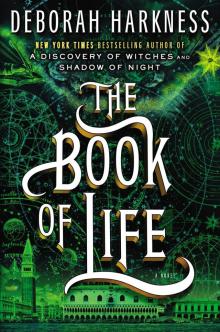 The Book of Life
The Book of Life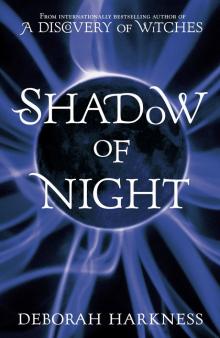 Shadow of Night
Shadow of Night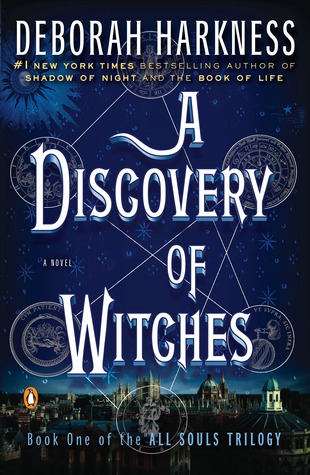 A Discovery of Witches
A Discovery of Witches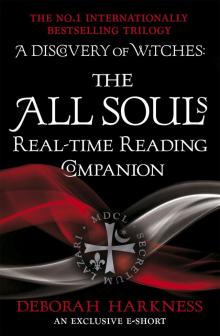 The All Souls Real-Time Reading Companion
The All Souls Real-Time Reading Companion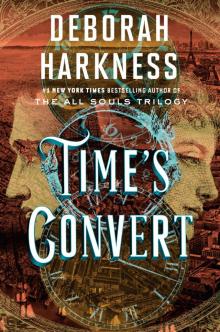 Time's Convert
Time's Convert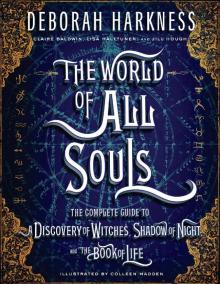 The World of All Souls
The World of All Souls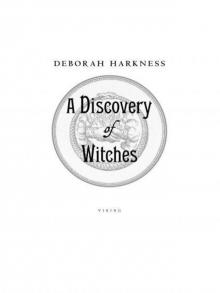 A Discovery of Witches: A Novel (All Souls Trilogy)
A Discovery of Witches: A Novel (All Souls Trilogy) Shadow of Night: A Novel
Shadow of Night: A Novel